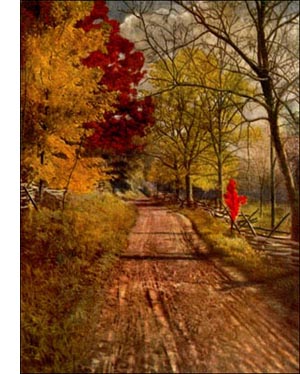Monterey Cypress Tree
 Monterey Cypress (Cupressus macrocarpa, Gord.)-A broad pyramidal tree when young, 40 to 75 feet high, becoming gnarled and flat topped when old. Trunk short, 3 to 6 feet thick. Bark brown to pale grey, broken into irregular ridges, covered with elongated, persistent scales. Wood brown, hard, strong; heavy, durable, fine grained. Leaves ovate, minute, closely appressed to twigs. Flowers minute, monoecious, separated, terminal, yellow. Fruit clustered, erect, globular cones, of few woody scales, seeds t8 to 20 under each middle scale. Preferred habitat, exposed coast bluffs. Distribution, around Bay of Monterey, California. Uses: Planted for windbreaks and hedges, and for ornament.
Monterey Cypress (Cupressus macrocarpa, Gord.)-A broad pyramidal tree when young, 40 to 75 feet high, becoming gnarled and flat topped when old. Trunk short, 3 to 6 feet thick. Bark brown to pale grey, broken into irregular ridges, covered with elongated, persistent scales. Wood brown, hard, strong; heavy, durable, fine grained. Leaves ovate, minute, closely appressed to twigs. Flowers minute, monoecious, separated, terminal, yellow. Fruit clustered, erect, globular cones, of few woody scales, seeds t8 to 20 under each middle scale. Preferred habitat, exposed coast bluffs. Distribution, around Bay of Monterey, California. Uses: Planted for windbreaks and hedges, and for ornament.The Pacific coast forests thrill the heart of the Easterner, unless that heart be petrified by commercialism. Even then, the thrill is there, though it be a materialistic vibration, accompanied by a mental estimate in terms of board feet. The thrill changes from wonder to pity as the tree lover looks upon that small remnant of its race, the Monterey cypresses, that cling to the wind-beaten promontories about Monterey Bay. They look like battle-scarred veterans making a stubborn though hopeless stand in the last ditch. And that, literally, is the state of their fortunes. Wide as their gnarled roots range for foothold, the crumbling bluffs are gradually undermined by the waves, and one by one those in the front rank go down. The hungry waves will never give up the siege, and the last of the trees in their native soil will in time be swept out of existence.
Fortunately the species is hardy and happy in cultivation far from its native land. It is known in several horticultural forms as well as the type species in temperate South America, Australia and New Zealand. In southern and western Europe it is in great favour, and at home it is planted very generally for ornament and for hedges up and down the Pacific coast. Lately it is coming into use in the Southeastern States. Hence, the tree is saved to a larger life by man's intervention, although Nature ruthlessly lets extermination overtake it in the struggle for existence. It is to be hoped that age will bring these cultivated cypresses to something like the picturesque habit that distinguishes the trees that grow wild. No pine of the Alps ever took on such grotesqueness as marks the Monterey cypresses.